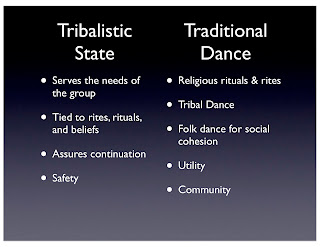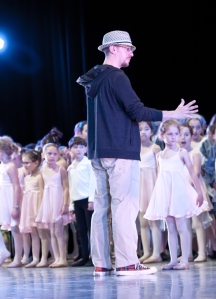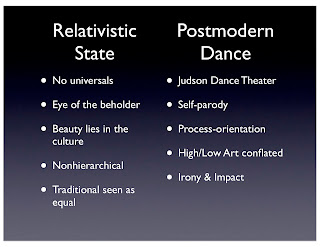Dance Paradigms (Part 3: Traditional Dance)
While each form and paradigm has its traditions, I use 'traditional' as it refers to the perspectives that pre-date classical, modern, and postmodern times. For dance, this includes tribal and folk (or social) dance. Traditional dance, as I describe it, aligns with Graves’ Tribalistic system.
In the Gravesian Tribalistic system, people “develop ritualistic ways full of totems and taboos which is their way to control by incantation and of assuring themselves that they are going to continue to have that which is necessary to take care of their basic needs” (Graves 219).
Tribal dance, first and foremost, serves the needs of the group and is tied inextricably to their rites, rituals, and beliefs. This is the prime motivation and need for dance at this perspective.
While Traditional dance historically can be found in tribal, folk, and social dance forms, it is also found in present day recreational dance situations and studios. I started classes at thirteen and enjoyed the camaraderie of my classmates more than anything else. I felt I belonged within the group. I had found my tribe (or clan).
Recreational dance studios often operate in this state. The recreational studio on Long Island I mentioned in previous posts was this way. They were a tribe and the owner was the motherly leader figure that worked, first and foremost, to ensure that all were safe within the clan.
These explanations and examples are admittedly general. There are cases that blur the lines and dance anthropologists could elaborate here. However, for the purposes of this inquiry, it is only important to have a grasp of traditional dance (from this perspective) as that which predates classical dance forms and to see the ritualistic motivations for the in-group of tribalistic dance or the socially cohesive values of folk or social dance as they apply both historically and in today’s world.
When individuals in Traditional cultures (historically or presently) start to express themselves, displaying their prowess, in contrast to others, they display a transition toward the motivations of the Gravesian Egoistic system that aligns with Popular Dance...
Graves, Clare W. The Neverending Quest. California: ECLET, 2005.



Comments
Post a Comment